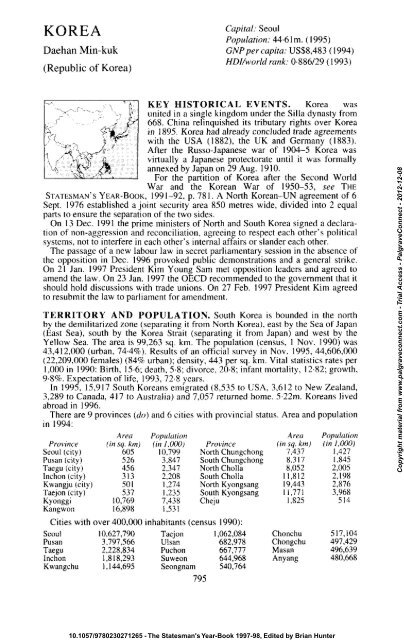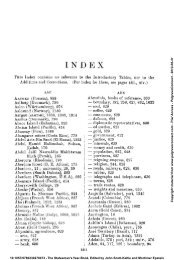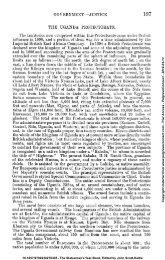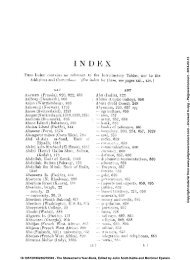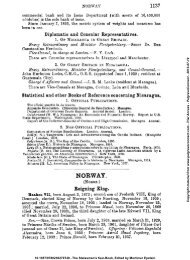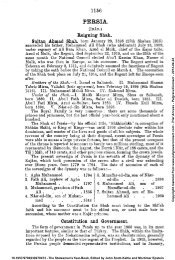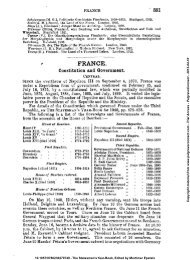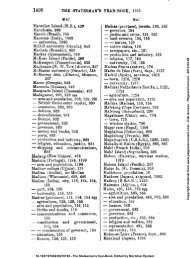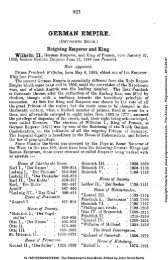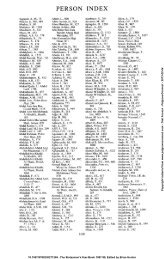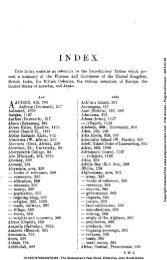Daehan Min-kuk (Republic of Korea) - Palgrave Connect
Daehan Min-kuk (Republic of Korea) - Palgrave Connect
Daehan Min-kuk (Republic of Korea) - Palgrave Connect
Create successful ePaper yourself
Turn your PDF publications into a flip-book with our unique Google optimized e-Paper software.
KOREA<br />
<strong>Daehan</strong> <strong>Min</strong>-<strong>kuk</strong><br />
(<strong>Republic</strong> <strong>of</strong> <strong>Korea</strong>)<br />
Capital: Seoul<br />
Population: 44-6lm. (1995)<br />
GNPper capita: US$8,483 (1994)<br />
HDI/world rank: 0-886/29 (1993)<br />
KEY HISTORICAL EVENTS. <strong>Korea</strong> was<br />
united in a single kingdom under the Silla dynasty from<br />
668. China relinquished its tributary rights over <strong>Korea</strong><br />
in 1895. <strong>Korea</strong> had already concluded trade agreements<br />
with the USA (1882), the UK and Germany (1883).<br />
After the Russo-Japanese war <strong>of</strong> 1904-5 <strong>Korea</strong> was<br />
virtually a Japanese protectorate until it was formally<br />
annexed by Japan on 29 Aug. 1910.<br />
For the partition <strong>of</strong> <strong>Korea</strong> after the Second World<br />
War and the <strong>Korea</strong>n War <strong>of</strong> 1950-53, see THE<br />
STATESMAN'S YEAR-BOOK, 1991-92, p. 781. A North <strong>Korea</strong>n-UN agreement <strong>of</strong> 6<br />
Sept. 1976 established a joint security area 850 metres wide, divided into 2 equal<br />
parts to ensure the separation <strong>of</strong> the two sides.<br />
On 13 Dec. 1991 the prime ministers <strong>of</strong> North and South <strong>Korea</strong> signed a declaration<br />
<strong>of</strong> non-aggression and reconciliation, agreeing to respect each other's political<br />
systems, not to interfere in each other's internal affairs or slander each other.<br />
The passage <strong>of</strong> a new labour law in secret parliamentary session in the absence <strong>of</strong><br />
the opposition in Dec. 1996 provoked public demonstrations and a general strike.<br />
On 21 Jan. 1997 President Kim Young Sam met opposition leaders and agreed to<br />
amend the law. On 23 Jan. 1997 the OECD recommended to the government that it<br />
should hold discussions with trade unions. On 27 Feb. 1997 President Kim agreed<br />
to resubmit the law to parliament for amendment.<br />
TERRITORY AND POPULATION. South <strong>Korea</strong> is bounded in the north<br />
by the demilitarized zone (separating it from North <strong>Korea</strong>), east by the Sea <strong>of</strong> Japan<br />
(East Sea), south by the <strong>Korea</strong> Strait (separating it from Japan) and west by the<br />
Yellow Sea. The area is 99,263 sq. km. The population (census, 1 Nov. 1990) was<br />
43,412,000 (urban, 74-4%). Results <strong>of</strong> an <strong>of</strong>ficial survey in Nov. 1995, 44,606,000<br />
(22,209,000 females) (84% urban); density, 443 per sq. km. Vital statistics rates per<br />
1,000 in 1990: Birth, 15-6; death, 5-8; divorce, 20-8; infant mortality, 12-82; growth,<br />
9-8%. Expectation <strong>of</strong> life, 1993, 72-8 years.<br />
In 1995, 15,917 South <strong>Korea</strong>ns emigrated (8,535 to USA, 3,612 to New Zealand,<br />
3,289 to Canada, 417 to Australia) and 7,057 returned home. 5-22m. <strong>Korea</strong>ns lived<br />
abroad in 1996.<br />
There are 9 provinces (do) and 6 cities with provincial status. Area and population<br />
in 1994:<br />
Province<br />
Seoul (city)<br />
Pusan (city)<br />
Taegu (city)<br />
Inchon (city)<br />
Kwangju (city)<br />
Taejon (city)<br />
Kyonggi<br />
Kangwon<br />
Cities with sver 400,000 inhabitants (census 1990):<br />
Seoul<br />
Pusan<br />
Taegu<br />
Inchon<br />
Kwangchu<br />
Area<br />
(in sq. km)<br />
605<br />
526<br />
456<br />
313<br />
501<br />
537<br />
10,769<br />
16,898<br />
10,627,790<br />
3,797,566<br />
2,228,834<br />
1,818,293<br />
1,144,695<br />
Population<br />
(in 1,000)<br />
10,799<br />
3,847<br />
2,347<br />
2,208<br />
1,274<br />
1,235<br />
7,438<br />
1,531<br />
Taejon<br />
Ulsan<br />
Puchon<br />
Suweon<br />
Seongnam<br />
795<br />
Province<br />
North Chungchong<br />
South Chungchong<br />
North Cholla<br />
South Cholla<br />
North Kyongsang<br />
South Kyongsang<br />
Cheju<br />
1,062,084<br />
682,978<br />
667,777<br />
644,968<br />
540,764<br />
Area<br />
(in sq. km)<br />
7,437<br />
8,317<br />
8,052<br />
11,812<br />
19,443<br />
11,771<br />
1,825<br />
Chonchu<br />
Chongchu<br />
Masan<br />
Anyang<br />
10.1057/9780230271265 - The Statesman's Year-Book 1997-98, Edited by Brian Hunter<br />
Population<br />
(in 1,000)<br />
1,427<br />
1,845<br />
2,005<br />
2,198<br />
2,876<br />
3,968<br />
514<br />
517,104<br />
497,429<br />
496,639<br />
480,668<br />
Copyright material from www.palgraveconnect.com - Trial Access - <strong>Palgrave</strong><strong>Connect</strong> - 2012-12-08
796 KOREA<br />
CLIMATE. The extreme south has a humid warm temperate climate while the<br />
rest <strong>of</strong> the country experiences continental temperate conditions. Rainfall is concentrated<br />
in the period April to Sept. and ranges from 40" (1,020 mm) to 60" (1,520<br />
mm). Pusan. Jan. 36°F (2-2°C), July 76°F (24-4°C). Annual rainfall 56" (1,407 mm).<br />
Seoul. Jan. 23°F (-5°C), July 77°F (25°C). Annual rainfall 50" (1,250 mm).<br />
CONSTITUTION AND GOVERNMENT. The 1988 Constitution provides<br />
for a President, directly elected for a single 5-year term, who appoints and heads a<br />
State Council, and a National Assembly (299 members) directly elected for 4 years<br />
(253 from constituencies and 46 from party lists in proportion to the overall vote).<br />
Presidential elections were held on 18 Dec. 1992. The electorate was 29,422,658;<br />
turn-out was 81-9%. Kim Young Sam was elected by 42% <strong>of</strong> votes cast.<br />
Presidential elections were scheduled for 18 Dec. 1997.<br />
Elections to the National Assembly were held on 11 April 1996. 1,389 candidates<br />
stood. The electorate was 31,526,918; turn-out was 63-9%. The New <strong>Korea</strong> Party<br />
won 139 seats with 34-5% <strong>of</strong> votes cast; the National Congress for New Politics, 79<br />
with 25-3%; the United Liberal Democrats, 50 with 16-2%; the Democratic Party,<br />
15 with 11-2%; ind, 16 with 11-9%.<br />
President: Kim Young Sam (b. 1927; DLP; sworn in 25 Feb. 1993).<br />
On 26 Feb. 1997 the government resigned. Koh Kun (b. 1938) was appointed<br />
Prime <strong>Min</strong>ister on 4 March 1997.<br />
National flag: White charged in the centre with the yang-um in red and blue and<br />
with 4 black p 'algwae trigrams.<br />
National anthem: 'Tong hae mulgwa' ('Until the East Sea is drained'); words<br />
anonymous, tune by An Ik Tae.<br />
Local Government. The 15 provinces are divided into 136 districts (Gun) and<br />
68 cities (Shi). Elections were held on 27 June 1995 for the 9 provinces and 6 cities<br />
<strong>of</strong> provincial status and 5,700 other local government posts. The DLP gained 5<br />
governorships, the DP 4, the UPP 4 and ind 2.<br />
DEFENCE. Peacetime operational control, which had been transferred to the<br />
Combined Forces Command (CFC) under a US general in July 1950 on the outbreak<br />
<strong>of</strong> the <strong>Korea</strong>n War, was restored to South <strong>Korea</strong> in Dec. 1994. In the event <strong>of</strong><br />
a new crisis, operational control over the <strong>Korea</strong>n armed forces will revert to CFC.<br />
Conscription is 26 months in the Army and 30 months in the Navy and Air Force.<br />
Conscripts may choose or be required to exchange military service for civilian<br />
work.<br />
Army. The Army is organized in 19 infantry and 3 mechanized infantry divisions, 2<br />
independent infantry brigades, 7 special forces brigades, 3 air defence artillery<br />
brigades, 3 counter-infiltration brigades, 1 army aviation command, 5 surface-to-air<br />
and 3 surface-to-surface missile battalions. Equipment includes 800 Type 88,<br />
400 M-47 and 850 M-48A5 main battle tanks. Army aviation equipment includes<br />
250 Hughes 500 and McDonnell Douglas 530 and 60 AH-IF helicopters for antiarmour<br />
operations, observation and liaison, and 18 CH-47D transport helicopters<br />
and 70 Bell UH-1 utility helicopters. Delivery <strong>of</strong> 150 UH-60 Black Hawk transport<br />
helicopters began in 1991 and is scheduled to continue until 1998. Strength (1997)<br />
548,000 (140,000 conscripts). Paramilitary Civilian Defence Corps, 3-5m.<br />
Navy. A substantial force <strong>of</strong> 60,000 (19,000 conscripts), including 25,000 marines<br />
(1996), continues its steady modernization programme. Current strength includes<br />
4 German-designed ocean-going diesel submarines, 3 midget submarines (175<br />
tonnes), 7 aged (1943^46) ex-US destroyers, and 33 locally-built frigates with<br />
modern US and European weapons, 4 corvettes, 11 fast missile craft, together with<br />
a patrol force <strong>of</strong> 100 inshore craft. There are 14 coastal mine counter-measure<br />
vessels and an amphibious force <strong>of</strong> 8 tank landing ships, 7 medium landing ships,<br />
together with 35 amphibious craft. Major auxiliaries include 2 replenishment and 2<br />
transport tankers, 2 large tugs, 4 survey vessels and 35 service craft. The Navy aviation<br />
element operates 8 P-3-C Orion, 15 shore-based S-2E Tracker anti-submarine<br />
10.1057/9780230271265 - The Statesman's Year-Book 1997-98, Edited by Brian Hunter<br />
Copyright material from www.palgraveconnect.com - Trial Access - <strong>Palgrave</strong><strong>Connect</strong> - 2012-12-08
KOREA 797<br />
aircraft and 25 Hughes 500MD, 12 Super-Lynx and 10 Alouette helicopters, some<br />
<strong>of</strong> which embark in frigates and destroyers.<br />
Main bases are at Chinhae, Inchon and Pusan.<br />
The Coastguard numbering some 5,000 (mostly shore-based) operates 10 <strong>of</strong>fshore,<br />
26 coastal and 38 inshore patrol craft as well as 9 light helicopters.<br />
Air Force. In 1996 the Air Force had a strength <strong>of</strong> 52,000 men and 450 combat aircraft.<br />
Its combat aircraft include 100 F-16C/D Fighting Falcons, about 180 F-4D/E<br />
Phantoms, 200 F-5E/F tactical fighters, 15 RF-4E Phantom reconnaissance fighters,<br />
10 0-2A and 10 OV-I forward air control aircraft and 10 Hughes 500 Defender<br />
helicopters. There are also 12 CN-235, 10 C-130 Hercules turboprop-engined transports,<br />
2 HS.748s, 1 Boeing 737 for VIP transport; UH-1, Bell 212 and Bell 412<br />
transport helicopters, and Hawk T-41, T-33, T-37C and T-38 trainers.<br />
INTERNATIONAL RELATIONS<br />
Membership. The <strong>Republic</strong> <strong>of</strong> <strong>Korea</strong> is a member <strong>of</strong> the UN and OECD.<br />
ECONOMY<br />
Policy. The seventh 5-year social and economic plan, which began in 1992, has<br />
been replaced by a new plan for 1993-97. An annual plan for 1995 aimed at controlling<br />
growth and strengthening national competitiveness. Part <strong>of</strong> the plan ('the<br />
core industrial sector system') was to make conglomerates (chaebol) more competitive<br />
by restricting the industrial areas in which they may engage. The major conglomerates<br />
had selected their core industries and companies early in 1994. Restrictions<br />
on chaebols were relaxed in 1995 where family owners reduced their holdings<br />
to less than 20%.<br />
40 state-owned or state-invested companies are scheduled for privatization between<br />
1995 and 1998.<br />
Performance. GDP growth rate was 7% in 1996 (9% in 1995).<br />
Budget. Revenue and expenditure (in 1,000,000m. won) at the 1997 budget: 67,770<br />
and 71,600. Sources <strong>of</strong> revenue: National tax, 64,230; non-tax, 3,540. Expenditure<br />
includes defence, 14,270; infrastructure, 10,130; education, 18,630; agriculture and<br />
fisheries, 6,670; technology, 3,220; environment, 2,110.<br />
Currency. The unit <strong>of</strong> currency is the won (KRW) notionally <strong>of</strong> 100 chon. Notes<br />
are in denominations <strong>of</strong> 10,000, 5,000 and 1,000 won and coins in denominations <strong>of</strong><br />
500, 100, 50, 10, 5 and 1 won. Notes and coins to the value <strong>of</strong> 9,234,600m. won<br />
were in circulation in 1993. In June 1995 foreign exchange reserves were<br />
US$28,380m.; gold reserves were US$34m. Inflation was 4-5% in 1996. In March<br />
1997, £1 = 1,410-19 won; US$1 = 864-35 won; DM1 =512-01 won.<br />
Banking and Finance. The central bank and bank <strong>of</strong> issue is the Bank <strong>of</strong> <strong>Korea</strong><br />
{Governor, Lee Kyung Shik). In June 1996 bank deposits totalled 326,030,000m.<br />
won, <strong>of</strong> which 146,850,000m. won were savings and time deposits.<br />
There are 23 national and provincial commercial banks, the 6 largest being Cho<br />
Hung, Commercial Bank, <strong>Korea</strong> First, Hanil, Bank <strong>of</strong> Seoul and <strong>Korea</strong> Exchange.<br />
There were 52 foreign banks in 1994, granted parity <strong>of</strong> treatment with domestic<br />
banks in July 1991, when the ceiling on their funds was lifted.<br />
In addition, there are non-bank financial institutions consisting <strong>of</strong> 20 insurance<br />
companies, the Land Bank <strong>of</strong> <strong>Korea</strong>, the Credit Guarantee Fund, 32 short-term<br />
financial companies, 237 mutual credit companies, and the Merchant Banking Corporation.<br />
The use <strong>of</strong> real names in financial dealings has been required since 1994.<br />
There is a stock exchange in Seoul.<br />
Weights and Measures. The metric system is in use alongside traditional<br />
measures. 1 sok= 144 kg. 1 pyong = 3-3 sq. metres.<br />
ENERGY AND NATURAL RESOURCES<br />
Electricity. Electricity generated (1994) was 188,348m. kWh; installed capacity<br />
10.1057/9780230271265 - The Statesman's Year-Book 1997-98, Edited by Brian Hunter<br />
Copyright material from www.palgraveconnect.com - Trial Access - <strong>Palgrave</strong><strong>Connect</strong> - 2012-12-08
798 KOREA<br />
(1993) was 27-65 kW. Sources <strong>of</strong> power in 1993: Nuclear, 40%; oil, 28-5%; coal,<br />
15%; liquefied natural gas, 12-3%; hydro-electric, 4-2%.<br />
<strong>Min</strong>erals. In 1991, 1,788 mining companies employed 60,983 people. <strong>Min</strong>eral<br />
deposits are small except tungsten. Output, 1993, included (in tonnes): Anthracite<br />
coal, 9-44m.; iron ore, 0-2m.; tungsten ore (1990), 2,451; limestone, 77m.; graphite,<br />
59,100; lead ore, 14,818; zinc ore, 27,616.<br />
Agriculture. Cultivated land was 207m. ha in 1992, <strong>of</strong> which l-31m. ha were rice<br />
paddies. In 1995, the farming population was 5-16m. and there were l-55m. farms.<br />
There were some 65,000 farms over 10 ha. The agricultural workforce was 2-8m. in<br />
1994.<br />
In 1995, 106m. ha were sown to rice. Production (1993, in tonnes): Rice,<br />
5,315,000; barley, 354,389; wheat, 552,000; potatoes, 243,000; beans, 212,000.<br />
There were 64,159 tractors in 1992.<br />
Livestock in 1992 (in 1,000): Draught cattle, 2,019; milch cows, 508; pigs, 5,463;<br />
sheep, 505; chickens, 73,324; ducks, 1,000.<br />
Forestry. Forest area was 6-47m. ha in 1992. Total stock (1995) was 257-3m. cu.<br />
metres. In 1995, 71% <strong>of</strong> the national forest was privately owned. Timber output was<br />
l-7m. cu. metres in 1992.<br />
Fisheries. In 1992, there was a total <strong>of</strong> 94,135 boats (959,056 gross tonnes).<br />
783 deep-sea fishing vessels were operating overseas in 1991. The fish catch<br />
(inland and marine) was 3-34m. tonnes in 1993.<br />
INDUSTRY. Manufacturing industry is concentrated primarily on oil, petrochemicals,<br />
chemical fibres, construction, iron and steel, cement, machinery,<br />
shipbuilding, automobiles and electronics. Tobacco manufacture is a government<br />
monopoly. Industry is dominated by giant conglomerates (chaebol). There were<br />
2-77m. businesses in 1995, <strong>of</strong> which 224,654 were incorporated. 521,496 businesses<br />
were in catering, 314,283 in manufacturing, 298,136 in services and 211,425 in<br />
transport and communications.<br />
Production in 1992 (in 1,000 tonnes): Paper and products, 2,568; artificial fertilizers,<br />
3,077; plastic products, 727; pig-iron, 19,238; steel bars, 1,055; steel angles,<br />
1,999; (in 1,000 sq. metres); Cotton fabrics, 469; silk fabrics, 18; synthetic fabrics,<br />
3,434; petrol, 5,476,000 kilolitres; shoes, 19-4m. pairs; l-6m. cars; 0-3m. lorries;<br />
7-17m. microwave ovens; l-3m. electronic calculators.<br />
Labour. In 1996 the population <strong>of</strong> working age (15 to 59 years) was 33-56m. The<br />
economically-active population was 20-79m., <strong>of</strong> whom 0-42m. were registered<br />
unemployed. In 1995, 4-77m. persons were employed in manufacturing, 1 l-22m. in<br />
services, l-93m. in building, 27,000 in mining and l-74m. in agriculture, fisheries<br />
and forestry. 5-84m. persons were self-employed in 1995. An annual legal minimum<br />
wage is set by the <strong>Min</strong>imum Wage Council each Sept, applicable to firms with<br />
more than 10 employees; in 1995-96 it was 288,250 won per month. In Sept. 1996<br />
the average monthly wage was 1,334m. The working week averaged 52-4 hours in<br />
1995. There were 235 labour disputes in 1992; 1,520,364 working days were lost.<br />
Legislation abolishing security <strong>of</strong> job tenure and giving employers powers to<br />
introduce flexible working hours and use substitute labour in the event <strong>of</strong> strikes<br />
was rushed through parliament in Dec. 1996, provoking public protests and a<br />
general strike.<br />
Trade Unions. In 1993 there were 7,531 unions with a total membership <strong>of</strong><br />
1,735,000. The government-recognized Federation <strong>of</strong> <strong>Korea</strong>n Trade Unions groups<br />
l-4m. <strong>of</strong> these. Civil servants may not join unions. Since 1997 unions have been<br />
permitted to engage in political activities, and the ban on more than one union in<br />
one work place is scheduled for abolition in 2002.<br />
FOREIGN ECONOMIC RELATIONS. Foreign debt was US$78,440m. in<br />
1995. Since 1991 foreign partners in joint ventures holding less than 50% <strong>of</strong> the<br />
capital have needed only to report, instead <strong>of</strong> seek approval for, their projects. Tax<br />
10.1057/9780230271265 - The Statesman's Year-Book 1997-98, Edited by Brian Hunter<br />
Copyright material from www.palgraveconnect.com - Trial Access - <strong>Palgrave</strong><strong>Connect</strong> - 2012-12-08
KOREA 799<br />
concessions for foreign investments have been reduced. Since 1994 foreign investors<br />
have been able to buy 15% <strong>of</strong> the equity <strong>of</strong> most <strong>Korea</strong>n companies. Since June<br />
1995 South <strong>Korea</strong>n businesses and individuals have been permitted to make investments<br />
and set up branch <strong>of</strong>fices in North <strong>Korea</strong>. South <strong>Korea</strong> donated 015m.<br />
tonnes <strong>of</strong> rice to North <strong>Korea</strong> in 1995.<br />
Commerce. In 1995 exports were US$125,058m., imports, US$135,119m. Trade in<br />
1994 with major partners (in USSlm.): Imports: Japan, 25,390; USA, 21,578;<br />
China, 5,463; Germany, 5,159. Exports: USA, 20,553; Japan, 13,523; Hong Kong,<br />
8,015; China, 6,203.<br />
Major exports in 1994 included (in US$lm.): Transistors and chips, 11,848; textiles,<br />
7,838; clothing, 5,653; ships, 4,945; motor cars, 4,470; iron and steel, 4,456;<br />
telecommunications equipment, 3,687; <strong>of</strong>fice machines, 3,607; chemicals, 2,116.<br />
Major imports included: Machinery and transport equipment, 37,408; mineral fuels,<br />
15,415; chemicals, 9,763; inedible raw materials, 9,405; food, 4,761. Rice imports<br />
were prohibited until 1994, but following the GATT Uruguay Round the rice<br />
market opened to foreign imports in 1995.<br />
Total trade between <strong>Korea</strong> and UK (British Department <strong>of</strong> Trade returns, in<br />
£1,000 sterling): / m (99} ]994 jgg5 /gg6<br />
Imports to UK 933,946 1,077,735 1,069,209 1,561,755 2,038,376<br />
Exports and re-exports from UK 654,060 796,380 970,978 1,153,116 1,303,560<br />
Tourism. In 1995, 3,818,740 <strong>Korea</strong>ns travelled abroad and 3,753,197 foreign<br />
nationals visisted South <strong>Korea</strong> (3,580,024 in 1994).<br />
COMMUNICATIONS<br />
Roads. In 1993 there were 61,295 km <strong>of</strong> roads. 11-6m. passengers and 345-8m.<br />
tonnes <strong>of</strong> freight were carried in 1994. In 1995 motor vehicles totalled 8,022,652<br />
(7,540,888 private) including 1,756,347 lorries, 601,571 buses and 5,632,838 passenger<br />
cars. There were 11,585 road deaths in 1992 (13,429 in 1991).<br />
Railways. In 1995 the National Railroad totalled 3,120 km <strong>of</strong> 1,435 mm gauge<br />
(557 km electrified) and 20 km <strong>of</strong> 762 mm gauge. In 1995 railways carried 817m.<br />
passengers and 574m. tonnes <strong>of</strong> freight.<br />
There are metros in Seoul (132 km) and Pusan (26-1 km).<br />
Civil Aviation. There are international airports at Seoul (Kimpo), Kimhae<br />
and Chaeju. The national carrier is <strong>Korea</strong>n Air which in 1995 operated<br />
6 A300B4-200s, 5 A300B4-600s, 16 A300B4-600Rs, 2 A300F4-200s, 3 B-727-200<br />
Advs, 4 B-747-200Bs, 2 B-747-200B(F)s, 1 B-747-200C, 8 B-747-200Fs,<br />
2 B-747-300s, 1 B-747-300 Combi, 16 B-747-400s, 1 B-747-400 Combi,<br />
2 B-7475Ps and 34 other aircraft. Asiana Airlines also provides services, and the<br />
foreign airlines Aer<strong>of</strong>lot, Air Canada, Air China, Air France, Air New Zealand,<br />
Alitalia, All Nippon Airways, British Airways, Cathay Pacific, China Eastern Airlines,<br />
China Northern Airlines, Continental Airlines and Air Micronesia, Delta,<br />
Garuda Indonesia, JAL, Japan Air System, KLM, Lufthansa, Malaysia Airlines,<br />
Northwest Airlines, Philippine Airlines, Qantas, Singapore Airlines, Swissair, Thai<br />
Airways, United Airlines, Uzbekistan Airways, VASP and Vietnam Airlines. In<br />
1994, 184m. passengers and 0-3 lm. tonnes <strong>of</strong> cargo were carried on domestic<br />
routes and 13-08m. passengers and 1-1 lm. tonnes <strong>of</strong> cargo on international routes.<br />
Shipping. In 1992 there were 48 ports, including 27 for international trade. In 1995<br />
the merchant marine comprised 684 vessels totalling 1949m. DWT, representing<br />
2-95% <strong>of</strong> the world's tonnage. 234 vessels (49-56% <strong>of</strong> tonnage) were registered<br />
under foreign flags. Total GRT, 7-01m., including oil tankers, 0-52m. GRT and container<br />
ships, M5m. GRT. 7-87m. passengers and 234m. tonnes <strong>of</strong> freight were<br />
carried on domestic routes in 1994, and 041m. passengers and 35342m. tonnes <strong>of</strong><br />
cargo on international routes.<br />
Telecommunications. Post <strong>of</strong>fices totalled 3,390 in 1995; public telephones,<br />
310,451; telephone subscribers, 18-08m.; telex subscribers, 4,006. l-65m. mobile<br />
phones were in use in 1995. The <strong>Korea</strong>n Broadcasting System (KBS) is a public<br />
10.1057/9780230271265 - The Statesman's Year-Book 1997-98, Edited by Brian Hunter<br />
Copyright material from www.palgraveconnect.com - Trial Access - <strong>Palgrave</strong><strong>Connect</strong> - 2012-12-08
800 KOREA<br />
corporation which broadcasts 4 national radio programmes (1 commercial), regional<br />
programmes and a service for <strong>Korea</strong>ns living abroad. An external service, Radio<br />
<strong>Korea</strong>, broadcasts in 10 languages. There is also a commercial network, an educational<br />
service and 4 religious networks. KBS transmits 3 TV channels (1 educational);<br />
colour by NTSC) and there is a commercial channel. Local commercial TV<br />
based on major cities began in 1994. Cable TV was inaugurated in March 1995 and<br />
had lm. subscribers in June 1996. There were 42m. radio and 8-7m. television<br />
receivers in 1993.<br />
Cinemas. In 1988 there were 696 with a seating capacity <strong>of</strong> 240,000. 96 full-length<br />
films were produced in 1992.<br />
Press. In 1992 there were 77 dailies and 4,994 periodicals. 29,56? book titles were<br />
published 1994.<br />
SOCIAL INSTITUTIONS<br />
Justice. Judicial power is vested in the Supreme Court, High Courts, District Courts<br />
and Family Court. The 14 Justices <strong>of</strong> the Supreme Court are appointed by the President<br />
for renewable 6-year terms; the Chief Justice appoints other judges. The President<br />
appoints the Prosecutor-General. The death penalty is authorized.<br />
Religion. The main religions have been Shamanism, Buddhism (introduced<br />
A.D. 372) and Confucianism, which was the <strong>of</strong>ficial faith from 1392 to 1910. Catholic<br />
converts from China introduced Christianity in the 18th century, but a ban on<br />
Roman Catholicism was not lifted until 1882. The Anglican Church was introduced<br />
in 1890 and became an independent jurisdiction in 1993 under the Archbishop <strong>of</strong><br />
<strong>Korea</strong>. In 1995 it had 84 churches, 110 priests and some 52,000 faithful. Religious<br />
affiliations <strong>of</strong> the population in 1991 (and 1985): Buddhism, 23-7% (27-7%);<br />
Protestantism, 16-3% (18-6%); Roman Catholicism, 4-8% (5-7%); Confucianism,<br />
1-5% (1%); others, 0-9% (1%); no religion, 52-9% (46%).<br />
Education. After 1 or 2 years <strong>of</strong> kindergarten, education is compulsory from 6 to<br />
12, followed by the options <strong>of</strong> middle school till 15 and general or vocational high<br />
school to 18.<br />
In 1992-93 there were 8,526 kindergartens with 263,562 pupils and 21,117 teachers;<br />
6,122 elementary schools with 4,561,078 pupils and 137,819 teachers; 2,539<br />
middle schools with 2,336,206 pupils and 93,439 teachers; 1,735 high schools with<br />
2,123,621 pupils and 95,208 teachers; 126 junior colleges with 294,412 students<br />
and 10,146 teachers; 11 teacher training colleges with 14,347 students and 603 teachers;<br />
121 colleges and universities with 814,426 students and 37,031 teachers;<br />
9 open colleges with 231,197 students and 1,179 teachers; and 287 other institutions<br />
with 185,370 students and 8,199 teachers.<br />
106,458 South <strong>Korea</strong>ns were studying abroad in 1994.<br />
Health. In 1992 there were 236 general hospitals (with 76,619 beds), 337 other hospitals<br />
(36,425), 4,901 oriental medical hospitals and clinics (2,096) and 6,639 dental<br />
hospitals and clinics. There were 48,390 physicians, 6,839 oriental medical doctors,<br />
11,285 dentists, 8,012 midwives, 101,140 nurses, and 39,564 pharmacists.<br />
Social Security. In 1992 502m. persons were covered by the National Pension System<br />
introduced in 1988. Employers and employees make equal contributions; persons<br />
joining by choice or in rural areas pay their own contributions. The System<br />
covers age pensions, disability payments and survivors' pensions. Recipients <strong>of</strong><br />
benefit in 1992 included: Public livelihood aid, 2-42m.; veterans, 174,100.<br />
Under a sytem <strong>of</strong> unemployment insurance introduced in July 1996, workers laid<br />
<strong>of</strong>f after working at least 1 year for a member employer are entitled to benefits<br />
averaging 50% <strong>of</strong> their previous wage for a period <strong>of</strong> 30 to 210 days.<br />
DIPLOMATIC REPRESENTATIVES<br />
Of <strong>Korea</strong> in Great Britain (4 Palace Gate, London, W8 5NF)<br />
Ambassador: Choi Dong Jin.<br />
10.1057/9780230271265 - The Statesman's Year-Book 1997-98, Edited by Brian Hunter<br />
Copyright material from www.palgraveconnect.com - Trial Access - <strong>Palgrave</strong><strong>Connect</strong> - 2012-12-08
KOREA 801<br />
Of Great Britain in <strong>Korea</strong> (4 Chung-Dong, Chung-Ku, Seoul)<br />
Ambassador: Stephen D. Brown.<br />
Of <strong>Korea</strong> in the USA (2370 Massachusetts Ave., NW, Washington, D.C., 20008)<br />
Ambassador: Kun Woo Park.<br />
Of the USA in <strong>Korea</strong> (Sejong-Ro, Seoul)<br />
Ambassador: James T. Laney.<br />
Of <strong>Korea</strong> at the United Nations:<br />
Ambassador: Park Soo Gil.<br />
Further Reading<br />
National Bureau <strong>of</strong> Statistics. <strong>Korea</strong> Statistical Yearbook<br />
Bank <strong>of</strong> <strong>Korea</strong>. Economic Statistics Yearbook<br />
Cumings, B., <strong>Korea</strong>'s Place in the Sun: a Modern History. New York, 1997<br />
Das, D. K., <strong>Korea</strong>n Economic Dynamism. London, 1991<br />
Eckert, C. J. etal, <strong>Korea</strong> OldandNew: a History. Harvard Univ. Press, 1991<br />
Gibney, F., <strong>Korea</strong>'s Quiet Revolution: from Garrison State to Democracy. New York, 1992<br />
Kang, M.-H. The <strong>Korea</strong>n Business Conglomerate: Chaebol Then and Now. Univ. <strong>of</strong> California<br />
Press, 1996<br />
Kim, D.-H. and Tat, Y.-K. (eds.) The <strong>Korea</strong>n Peninsula in Transition. London, 1997<br />
Simons, G., <strong>Korea</strong>: the Search for Sovereignty. London, 1995<br />
Song, P.-N., The Rise <strong>of</strong> the <strong>Korea</strong>n Economy. 2nd ed. OUP, 1994<br />
Tennant, R., A History <strong>of</strong> <strong>Korea</strong>. London, 1996<br />
National statistical <strong>of</strong>fice: National Bureau <strong>of</strong> Statistics, Economic Planning Board, Seoul<br />
10.1057/9780230271265 - The Statesman's Year-Book 1997-98, Edited by Brian Hunter<br />
Copyright material from www.palgraveconnect.com - Trial Access - <strong>Palgrave</strong><strong>Connect</strong> - 2012-12-08


